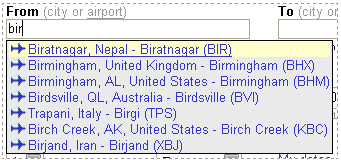Five Accessibility Tips For Ajax-based Website Interfaces
Ajax, the cool interface technology utilized to update and modify web pages without requiring a full refresh of the page is gaining more and more popularity on sites all over the Internet.

Photo credit: Davide Guglielmo
But as much as Ajax can significantly simplify and ease user interaction with specific forms and data, it can also become a liability when it comes to provide as much benefit to handicapped or visually impaired viewers.
Understanding where Ajax can fall short of its promises and considering some basic solutions that can be utilized in such situations is just the first basic step a professional online publisher should take to increase effective accessibility to everyone.
AJAX Accessibility for Websites
by Brigitte Simard
AJAX or Asynchronous JavaScript and XML, is an innovative way of using existing technologies to create highly interactive web applications.
AJAX allows portions of the page to be updated without having to refresh and reload the entire page. It can increase site performance significantly and provide cutting edge user interfaces.
Unfortunately it can also be a source of concern for delivering fully accessible web sites.
What is AJAX?

Photo credit: svilen001
AJAX is not a new technology in itself but a new approach to programming websites based on the following web standards:
The key word is asynchronous - AJAX applications work 'behind the scenes' with the web server to dynamically update the content of a web page.
JavaScript plays an important role in this process, trading data with the server and manipulating the information on the page.
Accessibility Benefits of AJAX

Photo credit: star-one
As well as significantly improving the user experience AJAX applications can also enhance accessibility. For example:
- Auto-suggest dropdowns can help both users with reading difficulties and motor impairments

e.g. City and airport suggestions are offered as users enter text Screenshot of Kayak auto-suggest dropdown - Drag & drop sliders can help users with reading difficulties due to their illustrative nature

e.g. A click-and-drag slider is used to filter search criteria Screenshot of Amazon drag & drop sliders
Accessibility Issues Caused by AJAX

Photo credit: forwardcom
AJAX and JavaScript are usually used to update page content. When this happens screen readers respond in a variety of different ways, depending on both the screen reader and the browser:
- Screen readers aren't aware of the changes so will read out the unmodified version of the page. This means screen reader users don't get the updated content of the page.
- Screen readers are aware of the changes but will only read the modified content when they naturally reach it. This is fine unless the modified content precedes users' current location. If this happens, they're unlikely to hear this content.
- Screen readers start reading the modified page but from the very top. This means that users have to essentially listen to all of the page content again. It can be difficult for these users to know which content has been updated and where in the page this content is.
- Screen readers are automatically taken to the modified content so users instantly know that page content has been updated - this can however severely disorientate users.
Screen magnifier users might not notice changes that have occurred outside the areas they're interacting with.
They can therefore miss out on important information especially if the changed content takes place above their current location on the page.
Finally, AJAX requires JavaScript to be enabled.
Although assistive technologies can now handle many uses of JavaScript they don't all provide complete support.
Recommendations for AJAX and Accessibility

Photo credit: sundesigns
There's one key question to consider when planning the development of a website and the use of AJAX: Is there a real need to use AJAX?.
If the answer is yes, then ensure the following is true to ensure AJAX accessibility is optimised:
Inform Users Early in the Page that Dynamic Updates Will Occur
Not all users are familiar with AJAX interfaces.
Let them know that changes may take place so they can expect and look for these changes.
This is particularly important for screen reader and magnifier users as they may be unaware that changes have taken place.
Highlight the Areas That Have Been Updated
Using subtle changes to highlight areas that have changed, for just a short period of time, can be most helpful.
It will inform users, in particular those with reading difficulties that updates have taken place.
Don't Change the Focus
Do not move the focus of the page to where the change has taken place.
Changing the focus can be disrupting for screen reader and magnifier users especially if there are no mechanisms to return to the previous position.
Offer the Option to Disable Automatic Updates
Allow users to manually request page updates, for example by providing links and/or form buttons to refresh the page on-demand.
Screen reader and magnifier users may be unaware of on-the-page changes.
It can also be difficult for users with reading difficulties to keep up with automatic updates.
If possible, store users' preferences for requesting page updates for future visits to the site.
Ensure the Site Works If JavaScript Is Not Enabled
Build a standard application then overlay it with AJAX to improve its functionality.
If JavaScript is disabled or not available then users will still be able to use the site.
In case of an advanced AJAX application, consider providing an HTML alternative.
If the AJAX application is impossible to use by group of users (e.g. if it relies on the use of a mouse, such as the drag & drop sliders) then a link to an HTML alternative is a must.
Originally written by Brigitte Simard for WebCredible and first published as AJAX accessibility for websites on March 2008
Reference: Web Credible [ Read more ]

blog comments powered by Disqus